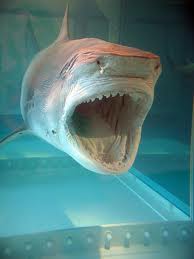PINKY SAYS: HOW TO UNDERSTAND DAMIEN HIRST
This is the most difficult blog I have ever tried to write. How do I approach the work of a famous artist that I do not understand? I think the best that I can do is to make a concerted effort. So here we go. Hirst was born in Bristol in 1965 and grew up in Leeds. His recognized father, a car salesman, left the family when Hirst was 12. However his mother later informed him that his true sire was another man. That really does not matter in the scheme of things. Hirst was difficult to control and was arrested three times for shoplifting. This too should be ignored because he remained in school and studied at a local college in Leeds. While there he studied and drew cadavers in the anatomy department of the University of Leeds and this seems to have made a lasting impression on him. He was then admitted to Goldsmiths which was at that time an incubator for conceptualist art. He then became a member of a group known as Y.B.A. (Young British Artists) whose aim was to combine conceptual art understanding with a need to dazzle and provoke the largest audience they could. They seemed to get off on death, sex and squalor. And so there were YBA works such as a light box with a photograph of a bullet wound or a bed with stained sheets, condoms and dirty underwear. Their point was to be painterly yet arouse in the viewer a confusion in their response. Something about his work forced Charles Saatchi, an influential art collector, to consider him and support his work. Hirst then received the approval of Nicholas Serota of the Tate and Norman Rosenthal of the Royal Academy. This was the start of his rocketing success as an artist. He aroused public outrage with his absolutely vulgar works in Britain.
It is not difficult to trace the blood lines of Hirst’s forbears. Thus metaphorically Jeff Koons is a first cousin, Marcel Duchamp a grandfather and Francis Bacon an uncle. Hirst caused one of the larger shocks to the public with his shark in a vitrine. His huge dead shark in an aqueous fluid within a superbly finished tank challenges the viewer, but immersed animal corpses have a way of deteriorating. This however is of little concern to Hirst since both his dead animals and his fluid suspensions can be replaced. Duchamp once said that art is created partly by the artist and partly by what the viewers of the art contribute. Hirst’s art works are in direct descent from Koons basketballs in flotation tanks. One critic of Hirst said that the problem lies in the fact that Hirst dumps pretty much the whole transaction into the lap of the audience. Certainly David Hockney’s angers arise from the challenge made to him by Hirst’s art. Hockney’s poster at the Royal Academy read, “All the works here were made by the artist himself, personally.” But in truth Andy Warhol seems to have accepted and authenticated the concept of the CONCEPT being the important aspect of the work of art, not its execution, and that was 50 years ago. His silk screened Marilyns were done by workshop assistants and yet they are the concept of Warhol.
Comes now into our world Damien Hirst’s global show. Entitled “The Complete Spot Paintings, 1986-2011”, the show is in eleven Larry Gagosian galleries–three in New York, two in London, and one each in Paris, Geneva, Rome, Athens, Hong Kong and Beverly Hills. The deliberate deadness of Hirst’s pickled animals is changed in his spot paintings so that they record 331 paintings stretched out globally around the world. A few of the early ones are by Hirst, but the balance are the work of his assistants. These consist of grid arrangements of colored disks painted in household gloss paint on white grounds. The colors or the disks seem to be distributed at random . Some are bright, others muted; some are warm, others cool. Thus while there is no logic to their appearance there is also no monotony. No two canvases are the same. They range in size from tiny to immense; they possess spots of color from just one to more than 25,000. They further the cause of abstraction. They are pleasantly distributed at random and they bear a distinct relationship to his formaldhyde animals; they are in fact brothers, elder and younger. Is it a farce? Hundreds of collectors worldwide would be insulted by this opinion. No law or esthetic principle can invalidate these paintings that are churned out by proxy and then bid up at auction as valid commodities. It is the concept conceived by Warhol, and executed by Lichtenstein and Gerhard Richter. And it is the viewer and the viewer alone who is the maker of the market. Some would say that Hirst is getting away with the great bamboozle. Hirst makes no bones about what the value of his work has come to. According to a prominent critic what it comes to next is somebody else’s move. Should I go back and take a another long hard look at the spots?



Leave a Reply